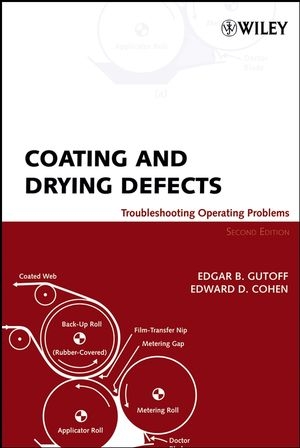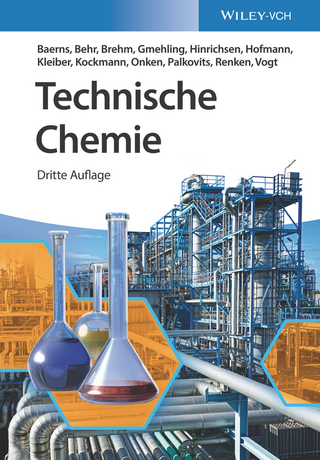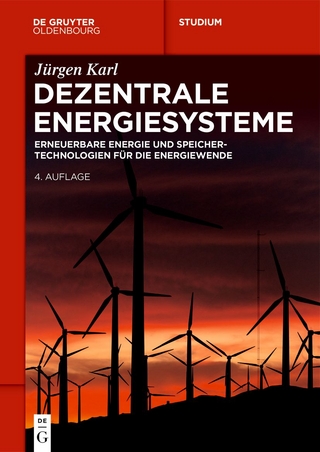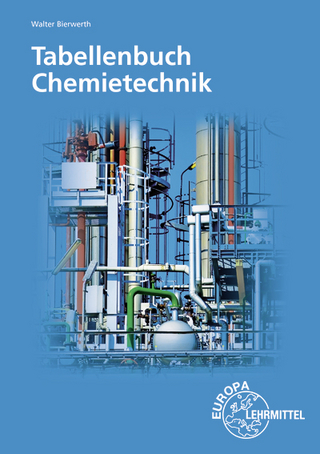
Coating and Drying Defects
Wiley-Interscience (Verlag)
978-0-471-71368-5 (ISBN)
A practical guide for ensuring a defect-free coating and drying process For professionals in the coating and drying industry, the world is a demanding place. New, technically complex products such as fuel cell membranes, thin film batteries, solar cells, and RFID chips require coatings of extreme precision. With the bar raised so high, understanding how to troubleshoot and eliminate defects on a coating line is an essential skill for all personnel.
Coating and Drying Defects, Second Edition provides manufacturing and quality control personnel, equipment operators and supervisors, and plant engineers and scientists with the full complement of proven tools and techniques for detecting, defining, and eliminating coating defects and operating problems, and for ensuring that they do not recur.
Updating the valuable contents of the first edition, this practical Second Edition:
Describes all major processes for coating and drying of continuous film on sheets or webs
Covers technologies that have been recently developed to prevent defect formation and improve operating procedures
Provides a rational framework within which to assess and analyze virtually any defect that may arise
Offers step-by-step guidelines for conducting every phase of the troubleshooting process, including defect prevention
Going beyond simply describing a disparate set of troubleshooting techniques, this unique guide arms readers with a systematic, nonmathematical methodology encompassing the entire coating operation, becoming an indispensable resource for manufacturing and quality-control personnel as well as plant engineers, polymer scientists, surface scientists, organic chemists, and coating scientists.
EDGAR B. GUTOFF, SCD, is a consultant in coating and drying. He coedited Modern Coating and Drying Technology (Wiley) and coauthored The Application of Statistical Process Control to Roll Products as well as the first edition of this book. He was the first secretary of the International Society of Coating Science and Technology and served until 2002. He is a Fellow of the AIChE and of the Society for Imaging Science and Technology and an adjunct professor at Northeastern University. EDWARD D. COHEN, PhD, is a technical consultant in all aspects of the web coating process. He recently retired from DuPont Central Research and Development as a DuPont Fellow. Dr. Cohen is coeditor of Modern Coating and Drying Technology(Wiley) and coauthor of the first edition of this book. GERALD I. KHEBOIAN (Chapter 11 author) is a consultant on web transport systems. He has over thirty-five years' experience applying web handling systems, electrical drives, tension controls, and machine controls. He is past chairman of the national TAPPI Electrical Engineering Committee and of the TAPPI Drive Seminar Series.
Preface xv
Preface to the First Edition xvii
About the Authors xxi
1 Introduction 1
2 Troubleshooting or Problem-Solving Procedure 5
Basic Troubleshooting Principles 6
Detect the Defect 8
Define the Defect or Problem 9
Name the Defect 11
Problem Statement 15
Collect and Analyze Additional Data 16
Process Information 16
General Process Information 17
Analytical Data 19
Standard Operating Procedures 19
Analyze the Data and Identify Potential Causes of Problem 19
Eliminate the Problem 25
Document the Results 25
Use Results to Prevent Reoccurrence 27
References 27
3 Coater and Defect Analytical Tools 29
Overview of Analytical Tools 30
Analytical Methods to Characterize Defects 30
Defect Test Procedures 31
Video Enhanced Microscopy 31
Surface Characterization Techniques 33
Coater Characterization Instruments 38
Data Loggers 42
Rheological Measurements 44
Surface Properties 49
On-Line Characterization Systems 50
On-Line Inspection Systems 50
On-Line Coating Weight Measurement 52
On-Line Viscosity 54
Data Analysis Techniques 55
Keeping Current 56
References 61
4 Problems Associated with Feed Preparation 63
Dirt and Other Particulates 63
Filtration 64
Agglomerates 66
Bubbles 68
Poor Cross-Web Uniformity 69
In-Line Mixers 70
Temperature Control 70
Flow Control for Down-Web Uniformity 70
Feeding the Coating Liquid 70
Flow Control 72
Magnetic Flow Meters 72
Ultrasonic Meters 73
Coriolis Meters 73
References 74
5 Problems Associated with Roll Coating and Related Processes 75
Coating Methods 75
Control of Coating Weight 82
Ribbing 86
Ribbing in Forward Roll Coating 87
Ribbing and Cascade (or Herringbone or Seashore) in Reverse Roll Coating 89
Gravure Coating 92
Streaks and Bands in Roll Coating 92
Chatter in Roll Coating 94
Sagging 94
References 95
6 Problems in Slot Extrusion Slide and Curtain Coating 97
Description of Coating Methods 97
Limits of Coatability 107
The Window of Coatability 107
Slide Coating 109
Vortices and Eddies 110
Slot Coating 117
Extrusion Coating 124
Curtain Coating 126
Effect of Surface Roughness on the Limits of Coatability 128
Instabilities in Premetered Coating 131
Chatter 131
Ribbing 131
Neck-in 133
Scalloped Edges 133
Edge Beads and Heavy Edges 133
Waves in Slide and in Curtain Coating 135
Streaks and Bands in Premetered Coating 137
References 141
7 Coating Problems Associated with Coating Die Design 143
Cross-Web Uniformity 143
Temperature Control 148
Corrections to the Coating Die Internals 149
Die Internal Pressures and Spreading 150
Extrusion Dies 151
Wall Shear Stress Control and Residence Time Control 153
References 155
8 Surface Tension Driven Defects 157
Surfactants 158
Surface Tension Effects in Coating 159
Surface Tension Driven Defects 162
Convection or Bénard Cells 162
Craters 163
Fat Edges or Picture Framing 164
Nonuniform Edges in Multilayer Coatings 165
Dewetting and Crawling 166
Adhesive Failure and Delamination 167
Nonuniform Base Surface Energies 168
References 168
9 Problems Associated with Static Electricity 169
Formation of Charges 171
Electrostatic Fields 173
Surface Resistivity 174
Measurement of Static Charges 177
Removal of Charges 180
Free Charges 180
Bound Charges 182
References 183
10 Problems Associated with Drying 185
Dryer Control and Solvent Removal 189
Drying Condition Case History 195
Drying Defects 198
Air Bar Rubs 199
Blushing 199
Bubbles and Blisters 200
Cockle or Wrinkling 201
Curl 201
Mud Cracking 204
Delamination 204
Dryer Bands 205
Dryer Remelt 206
Dryer Contamination Spots 207
Dryer Condensation Spots 208
Haze 208
Mottle 208
Orange Peel and Crinkling 209
Overspray 209
Reticulation 209
Surface Blow-Around 211
Microscopic Defects 211
Starry Night 211
Pinholes 212
The Role of Dryer Simulation in Troubleshooting 212
The Role of Radiative Heating in Defect Reduction 214
References 215
11 Problems Associated with Web Handling 217
by Gerald I. Kheboian
Web 218
Web Characteristics and Problems Associated with the Web 219
Base Web Defects that Cause Wrinkling 219
Causes of Web Defects 221
Web Attributes 221
Web Camber 221
Web Cross-Machine Thickness Profile Variation 223
Basis Weight Profile Variation 225
Surface of the Web 225
Plastic Web 227
Web Transport Systems 228
Tension 230
Reasons Why Operators Must Change Tensions in Order to Successfully Transport Web 231
Unwind Stand 231
When to Use Drive Motors on an Unwind Stand 233
Web Control 234
Core Selection and Build-Down Ratio 235
Draw Rolls Pull Rolls Capstans 235
Web Slippage and What Slip Affects 235
Nip Rolls 236
Unnipped Rolls (Elastomer Rolls) 237
Suction Rolls 241
Suction Aprons or Tables 242
Increasing the Reliability of Draw Roll Sections 243
Tension Isolation 243
Differential Tension 244
Driving Web-Carrying Rolls Within a Dryer 245
The Rewinder 246
Use of Accumulators at the Rewind and Unwind 246
Surface/Center Rewinds 247
Center-Driven Winders 248
Drives for Laminators 248
When to Drive Both Laminator Rolls 249
Coating Roll Drives 249
Coating Defects—Sources and Some Solutions 249
Backlash Exists in Timing Belts Gearboxes and Geared Couplings 250
Chatter Caused by the Roll 251
Roll Unbalance 251
Nonconcentric Rolls 252
Coating Roll Drive Systems 252
Feedback Devices 254
Coating Supply System 254
Transmission of Vibration Through Structural Members to the Coating Stand 254
Effect of Dryer Design on Coating Quality 255
Troubleshooting ‘‘Sudden’’ Coating Problems 255
Monitoring Speeds and Tensions of Web 257
A Speed Monitoring System 257
Monitoring the Speed of Idler Rolls 257
Monitoring for Slip Conditions on High-Speed Coaters 258
Tension Monitoring Systems 258
Specifying the Tension Range 259
Why Is Tension Control Needed? 259
Effects of Wiring Practices on Tension Control 260
When Do You Use a Pure Speed Control? 261
Equipment Lists Avoid Problems and Help Plant Personnel 264
Frequency and Direction of a Speed Perturbation 265
Problems that Occur After the Machine Is in Production 266
Types of Tension Control Systems 266
Motor Current Regulation 268
Dancer Roll Control 268
Example of the Use of a Dancer in Close Proximity to an Air Roll 270
Using Air Roll Air Gap Control as a Dancer in the Dryer 270
Force Transducer Control 272
Sizing Strain Gauge Load Cells 274
Section Characteristics that Ensure Good Web Transport Control 274
Master or Lead Section 274
Using Load Cell Control in Close Proximity to an Air Roll 275
Defects that Occur When the Master Section Slips 275
Sections with Limited Ability to Control Web Transport or Tension 275
Dealing with Sections that Have Limited Ability to Control Tension 276
Sections that Always Slip or Almost Always Slip 277
Drive Features that Give the Operator Additional Tools 278
Tools that Are Used for Troubleshooting Drive Problems 278
Optical Alignment Tooling and Laser Technology 278
Machine Alignment: Avoiding Many Web Handling Problems 278
Experience: Dryers Installed with the Dryer Centerline Skewed from the Machine Centerline 279
Alignment Problems Due to Building Location in a Swamp or Tidal River 279
The Alignment Process 280
The Baseline 281
Checking the Alignment of a Size Press (Roll Coater) on a Paper Web 282
Knowing How Your Machine Operates Can Avoid Problems in the Future 283
Summary 284
References and Bibliography 284
12 The Role of Process Support Equipment 287
Introduction 287
Definitions 288
Defect Support Equipment Interactions 291
Support Equipment Effect on Defects 291
Mechanical Chatter 291
Serpentine Chatter 292
Poor Physical Uniformity 294
Ribbing 294
Bubbles 294
Contamination Spots 294
Low Overall Productivity 295
Defects Due to Static Electricity 295
Scratches 295
Streaks 296
Mottle 296
Coating Weight Nonuniformity in Premetered Applicators 297
Coating Weight Nonuniformity in Self-Metered and Doctor Coaters 297
Air Bar Rubs in a Floater Dryer 297
Dry Point Variability 298
Selection of Equipment 298
13 Coating Defects Database 299
Need for Coating Defects Database 299
Defects Database: Examples 302
Base Flake 303
Roll Repeats 303
Bubbles 303
Bacteria Bubbles 306
Aimcal Defects Lexicon: Guide to Web Coating Technology 306
Description of Lexicon 306
Need for Lexicon 306
Lexicon Overview 308
Lexicon Sections 308
Glossary 308
Troubleshooting Guide 309
Defect Image Section 310
Search Capability 310
Availability 312
References 314
14 Defect Prevention 315
Introduction 315
Define Product and Process Requirements 316
Ensure Availability of Valid Analytical Techniques 319
Ensure Web Coating Process Meets Specifications 319
Use Appropriate Coating Method 320
Develop and Implement Operational Procedures 321
Quantify and Understand Defect Losses 321
Use Structured Troubleshooting Protocol 325
Use Computer Database to Store and Share Information 325
Implement Improved Process Technology 327
Use Statistical Process Control 327
Develop Fundamental Process Understanding 328
Index 331
| Erscheint lt. Verlag | 8.9.2006 |
|---|---|
| Sprache | englisch |
| Maße | 183 x 255 mm |
| Gewicht | 776 g |
| Themenwelt | Naturwissenschaften ► Chemie ► Technische Chemie |
| Technik | |
| ISBN-10 | 0-471-71368-6 / 0471713686 |
| ISBN-13 | 978-0-471-71368-5 / 9780471713685 |
| Zustand | Neuware |
| Haben Sie eine Frage zum Produkt? |
aus dem Bereich


